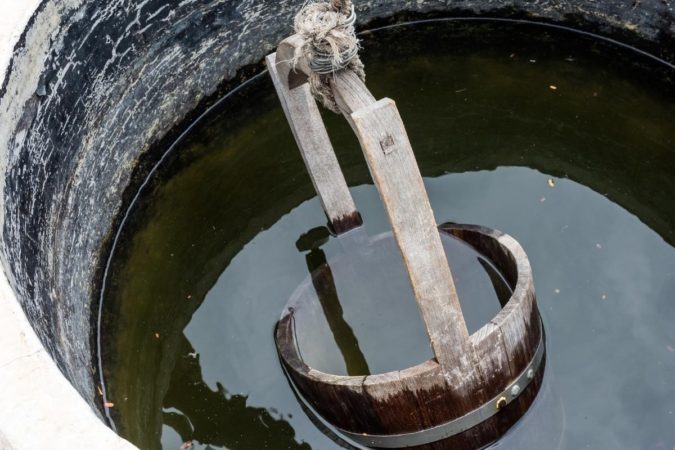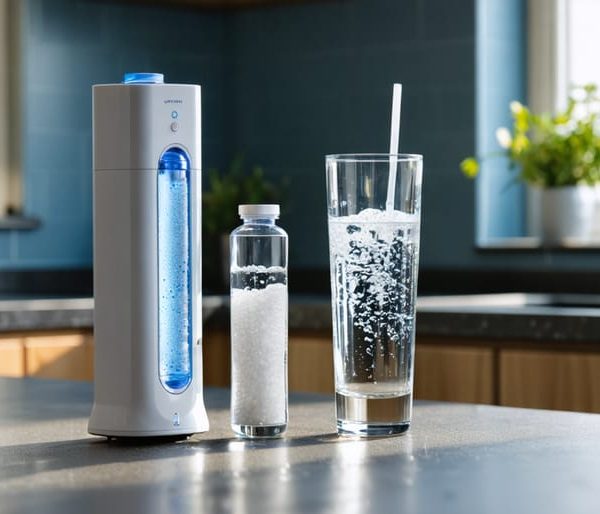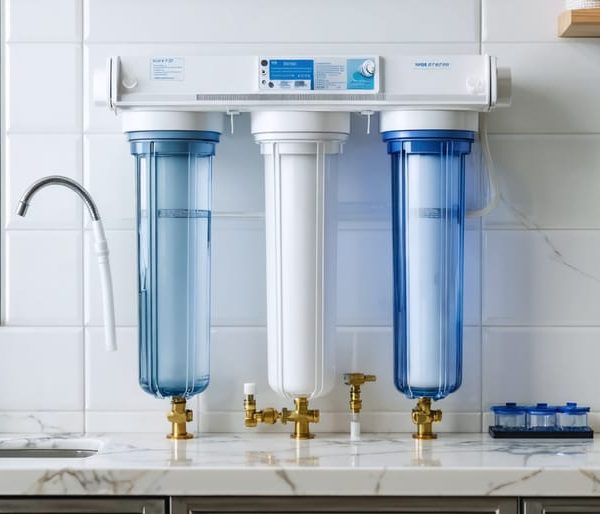Black sediment in well water is mainly caused by mineral deposits such as manganese and iron oxide, particles such as mud or soil, or decomposing organic matter.
According to the environmental protection agency, several elements surrounding your well can be the source of black sediments in your well water. They can easily seep through the water column and get to the well’s bottom.
There are several possible causes for the unusual presence of black particles in your drinking water. The best way to determine the precise cause is by having your water tested.
Causes of Black Sediment in Well Water
We will discuss the following causes of black sediments in your drinking water in detail:
Mineral Deposits
This is one of the major causes of the black sediments in your tap water. When you look at your well water with your naked eye, it may seem like sediment particles.
However, you’re looking at metals that have dissolved in well water. These dissolved metals will solidify when they’ve gained access to your plumbing system.
Significant amounts of mineral deposits in your water also causes water hardness. Then you’ll begin to notice scale deposits accumulating within your pipes, surfaces, and appliances, such as a pressure tank or water heater.
Certain minerals can easily be mistaken for black sediments, whereas they are black mineral ions. They include:
- Calcium carbonate
- Manganese
- Iron
Iron is a naturally-occurring mineral commonly found in soils and rocks. If your well water passes through an iron-rich soil or stone, you’ll notice rust stains on your sinks.
These rust stains can extend to your clothes if you use this well water for your laundry. Aside from iron, your well water can also mix with black particles and debris.
Similar to iron, manganese also occurs naturally in the soil and rocks. However, it’s an essential nutrient for our nervous system. Manganese in your drinking water can make it have a bitter, metallic, or bad taste. Again, this can also be coupled with black sediments or black debris.
The most common mineral that causes black sediments in water is calcium carbonate. Ironically, it’s not in any way harmful; it just messes with your water quality.
This mineral appears like small pieces of chalk or gravel. It’s the remnant of groundwater that has been exposed to dolomite rock or limestone.
Silt or Sand
Well water that runs over soil and rocks is bound to be discolored by silt or sand particles. These silt or sand particles usually sink to the well’s bottom. Therefore, they are usually seen during the conclusion of a water test.
Sand can also be drawn into your well water by a wrongly placed pump. Alternatively, it can be drawn in by a very powerful pump that’s too strong for pumping water out of your well.
Though it’s not particularly harmful to drink, it’s far from nice. The taste and quality are not praiseworthy either. Your well water may even be crunchy.
Mud
If heavy rain just fell or your well is located close to a floodplain, river, or a muddy area, fine particles from the soil will likely seep into your water supply.
This will result in muddy water. It may not be harmful to your health, but still likely to cause you problems.
Organic Matter
Another cause of black sediment in your water is the presence of organic matter at the bottom of your well. When this organic matter decomposes, it causes black debris in your well water, resulting in dirty water.
This cause of black sediment is easily identifiable because there will be a noticeable buildup in your well pump basket. You will also smell an unpleasant odor coming from your water pipes.
Sedimentation of this nature worsens over time and eventually clogs your well pump or the pipe feeding water to your house. This will lead to a buildup in pressure and can result in frequent repairs because things are more likely to break down.
Human Waste
If your home has a septic tank for sewage treatment, black sediments may seep into your well water from the system backup. This is caused by a release of sewage into the soil surrounding the well.
If it turns out that the black specks in your domestic water supply originate from human waste, you must act immediately to solve the problem. Human waste in your private well is very dangerous to one’s health. This is because your well will become a breeding ground for harmful bacteria and other disease-causing microorganisms.
Before tackling this problem, first ensure that the sudden appearance of black specks in your water is from your septic system.
If confirmed, reach out to a professional who specializes in repairing septic systems. They will assess the situation and let you know if there’s a need for repairs or not.
If repairs are needed, you will need to clean up your septic tank. Then, you’ll have to reseal it to ensure that waste matter doesn’t seep into the areas where your well gets water from.
Rubber From Your Water Heaters
If you have water heaters in your home or another water system that uses a rubber hose, it can cause black sediment in your well water.
There will be an occasional release of small quantities of black sediments into your well water. This is caused by a decomposed or eroded pipe.
Old Pipes
Less common reasons for black sediment in well water include the use of old pipes, inappropriate construction, a collapsed well, etc.
How to Get Rid of Black Sediment In Well Water?

To tackle the issue of the black stuff in your well water, there are several things you have to do. A convenient solution will be opting for bottled water, but that will only mean more environmental waste in the form of plastic bottles. Luckily, there’s a solution for each cause.
If iron is the primary cause of your water’s unpleasant odor, appearance, and taste, getting a filtration system can tackle that issue. The filtration system will eliminate manganese, iron, and other minerals from your well water supply.
If you already have a water filter and you’re experiencing this issue, then it means you need to replace the faulty filters.
Another thing to watch out for is the pH of your water. Low pH (acidic water) can result in the corrosion of pipes connected to your well.
The following methods can solve the problem of black sediments in your water:
Fix Faulty Septic Tanks and Old Rusty Pipes
If your septic system is responsible for the state of your well water, the issue is from human waste. Aside from having your septic tank handled by a professional like we recommended, also make sure you replace old hoses and rusty pipes.
With a functioning septic system and new pipes or hoses, the issue of black sediment in your water should be a thing of the past.
Install a Sediment Filter or a Sand Separator
Sediment filters are very effective in tackling the issue of water discoloration. Ensure you install them before the main water systems (as a pre-filter).
Sediment filters trap sediments responsible for foul smells and stains on clothes, surfaces, and appliances.
They can also eliminate small quantities of metals in your water, but they are not very effective in preventing mineral penetration. Their forte is mainly in sediment filtration.
The best type of sediment filter is the spin-down sediment filter because it utilizes a special screen. It’s also referred to as a mesh. It’s used to block sediment particles from passing through with your water.
If sand is the predominant sediment in your water, you should get a sand separator instead of a sediment filter. It’s usually installed after the well pump and before the pressure tank.
Its primary function is to prevent sand from seeping into the bottom of the well (the usual location of the pump).
Invest in Water Softeners
This is the obvious solution if a high concentration of minerals is the primary reason your well water is black. Aside from the appearance of your water, hard water is another side effect of a high concentration of minerals such as calcium and magnesium.
Hard water triggers scale deposits in your plumbing system, resulting in rust and corrosion. Hard water, if unchecked, can also leave scales on your home surfaces, faucets, and bathtubs. Even your kitchenware will be affected. However, with a water softener, you will eliminate water hardness.
The water softener uses a process called ion exchange to swap sodium ions for calcium and magnesium to produce soft water. As a result, your water will come out clear and clean.
Have Your Well Inspected
Sometimes, the problem may be how your well was drilled. Poor well drilling will likely result in water containing black sediments. The well casing, depth, water table, and other factors can also affect the state of water in your well.
Calling in a well drilling company is an excellent way to solve this problem. If the issue is from your well construction, they will ensure that your well is properly drilled.
Buy an Iron/Manganese Filter
This is arguably the most effective method to get rid of black sediment in your water.
Greensand filter
A good iron filter is the greensand filter, which utilizes its media to eliminate iron, manganese, and other contaminants from your water.
Once water flows through the greensand filter media, the minerals in your water will be oxidized into a state that will no longer affect the appearance or taste of your water.
Activated Carbon Filter
Another good iron filtration system is the activated carbon filter. It’s incredibly effective because it can remove many contaminants, including mineral ions. This filter usually comes with a sediment filter as a pre-filter.
Hydrogen Peroxide
Another way iron filters treat well water is by injecting certain chemicals such as hydrogen peroxide to treat the water. However, this is not an affordable process, so it’s not commonly used.
This chemical works just like the greensand filter. It oxidizes minerals such as manganese into a state that they won’t be able to alter the taste and appearance of your water.
To get the best results from an iron filtration system, you’ll need to maintain it regularly and treat it with chemicals.
Adding chlorine is another way as well.
Reverse Osmosis
Reverse osmosis filtration is a highly effective means of eliminating black sediment in your water. It involves numerous filtration phases such as the sediment pre-filter, a carbon media, the reverse osmosis membrane, and a post-filter.
This is the ideal solution for your water if the black sediments are caused by minerals and sediment such as silt, mud, or sand. The first filter (the pre-filter) removes the larger particles.
From there, it goes through the carbon media, where many chemical contaminants are removed. Finally, the main filter media (the RO membrane) removes the contaminants that managed to pass through the carbon media. This includes minerals such as iron, calcium, manganese, etc.
Finally, the post-filter adds finishing touches. By the end of the process, most minerals causing black sediment in your water will be eliminated.
The RO system works by utilizing huge pressure (sometimes from pressure tanks) to push water through the membrane to filter water.
Take Home
In conclusion, black sediments in water are more common than people realize, and it is not a difficult problem to solve. Common solutions usually include the installation of a manganese/iron filter or a sediment filter. If it is due to the state of your well or pipe, repairs or replacement will solve the problem.
However, before you consider any of the solutions mentioned above or causes, the first thing to do is to have your water tested. This will help you determine the precise cause and the solution.
When you don’t test your water, you may end up getting a filter for your water when the problem is a wrongly placed pump.



